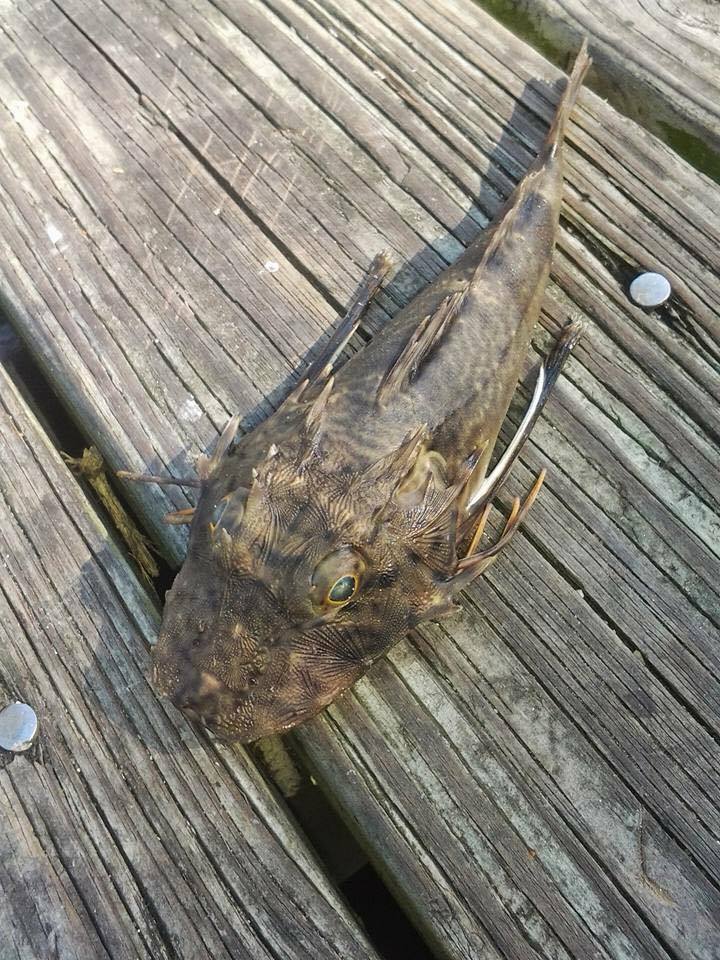According to a guy in a Facebook group I belong to, this fish was caught in the Missouri River near Omaha, NE, US. I have never seen one like it in my life, not in person or photo or anywhere. What on earth is this fish?! Is it even real? I've not seen it in person, only the photo below, but he says its real.
-
10$\begingroup$ Welcome to Biology.SE. I added a small coma to make sure you don't "belong to the fish" but to the "Facebook group". To ESL like me ponctuation is appreciable! $\endgroup$– Remi.bCommented Aug 18, 2015 at 16:39
-
15$\begingroup$ @Remi.b I hope it was a comma instead of a coma ;) $\endgroup$– canadianerCommented Aug 18, 2015 at 18:51
-
$\begingroup$ I thought it looked a lot like a sea robin which didn't make sense in context. Glad to find out sculpins and sea robins are very close in appearance indeed! $\endgroup$– chauxviveCommented Aug 18, 2015 at 19:15
-
1$\begingroup$ @Andy, we're discussing a different fish down in chauxvive's answer, and we may need a change of best answer! $\endgroup$– CKMCommented Aug 18, 2015 at 19:30
3 Answers
Original Answer
It looks to me like a species of sculpin, for example, the "short-horned sculpin" Myoxocephalus scorpius.
http://www.luontoportti.com/suomi/en/kalat/short-horn-sculpin
Best answer
After some deliberation, and it appears the other very good answer was for some reason removed: the OP fish appears to be a northern sea robin Prionotus carolinus.
This conclusion comes from the aid of user chauxvive, so much thanks for the identification, though his answer is oddly gone. The conclusion is based off of (1) the morphology of the head and face plate, (2) the longer and tapered pectoral fins, (3) the distinguishing long feelers at the sides anterior to the pectoral fin, and (4) the more probable distribution.
-
$\begingroup$ It indeed looks like a sculpin +1 However, would you expect to find this species in the Missouri river? (Caution: very bad naturalist and bad ichthyologist is commenting!) $\endgroup$– Remi.bCommented Aug 18, 2015 at 18:19
-
$\begingroup$ You know, my background doesn't give me any expertise here either, I'm just particularly good at acquiring information as needed. So to answer you, I'm really not sure out of experience. You definitely find sculpin in the Missouri River, but the distribution for the short-horned sculpin is certainly further north, which is why i could only provide it as an example, rather a clear-cut ID. $\endgroup$– CKMCommented Aug 18, 2015 at 18:24
-
1$\begingroup$ It definitely looks like what your answer says it might be, but I looked that up and it says its habitat is arctic coast! how would it have gotten to the Missouri River?! en.wikipedia.org/wiki/Myoxocephalus_scorpius $\endgroup$ Commented Aug 18, 2015 at 18:29
-
$\begingroup$ It's a really good question. I added a link to some info on sculpins, and there's a query to geographic distributions, you can use it to find a distribution for the specimen above and related. None seem to be endemic to the Missouri river if we're considering spiny sculpins, based on information I can find here $\endgroup$– CKMCommented Aug 18, 2015 at 18:47
-
2$\begingroup$ Sculpins are a good candidate at this point, but I hadn't considered the sea robins at first. Taking a look at Prionotus carolinus, this fish is in my opinion a better fit than a sculpin. The morphology of the face and mouth, and the presence of what appear to be feelers at the bottom of the fish (as opposed to horns) confirm this, I believe. $\endgroup$– CKMCommented Aug 18, 2015 at 20:09
I'm glad to see it may be indeed be a sea robin. Please vote for my answer here, if you don't mind, since my other post is gone. The pectoral fins were what I noticed first- robins have such unusual fins!
here's a great image, looks much like our fish here.
here's another anatomy of the sea robin. As you can see, it has pectoral fins much closer to this mystery fish than the sculpin.
This is an interesting discussion of the sea robin types and habitat The common sea robin is much larger than the northern and apparently the northern can stand much fresher water. Obviously this is outside of their range (which is along the coast and up brackish rivers of the Eastern US) but mystery fish could be a release. This isn't a popular tank fish, but you can buy and order them online (reference) They are pretty common in new england, apparently.
-
$\begingroup$ Your answer still looks like a comment and in its current form deserve being converted into a comment. You should edit it to include a picture and the reasons that make you think it is a sea robin and not something else. You can consider @kendall's answer as an example. Not however, that it is a little worthless to repost an answer that already exist (even though I understand you were first to suggest it a sea robin but again your answer just looked like a comment). $\endgroup$– Remi.bCommented Sep 2, 2015 at 17:18
-
$\begingroup$ Also you should not use answers to complain about how the StackExchange sites work. You can use the meta-sites (either Meta-Biology.SE or the more general meta.SE) to ask question about how the SE sites work and suggest improvements. $\endgroup$– Remi.bCommented Sep 2, 2015 at 17:20
I looked your strange fish and I think that it is a short horned sculpin because of its spikes.So, don't imagine that it is a sea robin because sea robins live in very deep waters (500 meters depth aproximately).In fact, I think that this sculpin was trapped in the river while it was going to the sea and the fishermen caught it.



